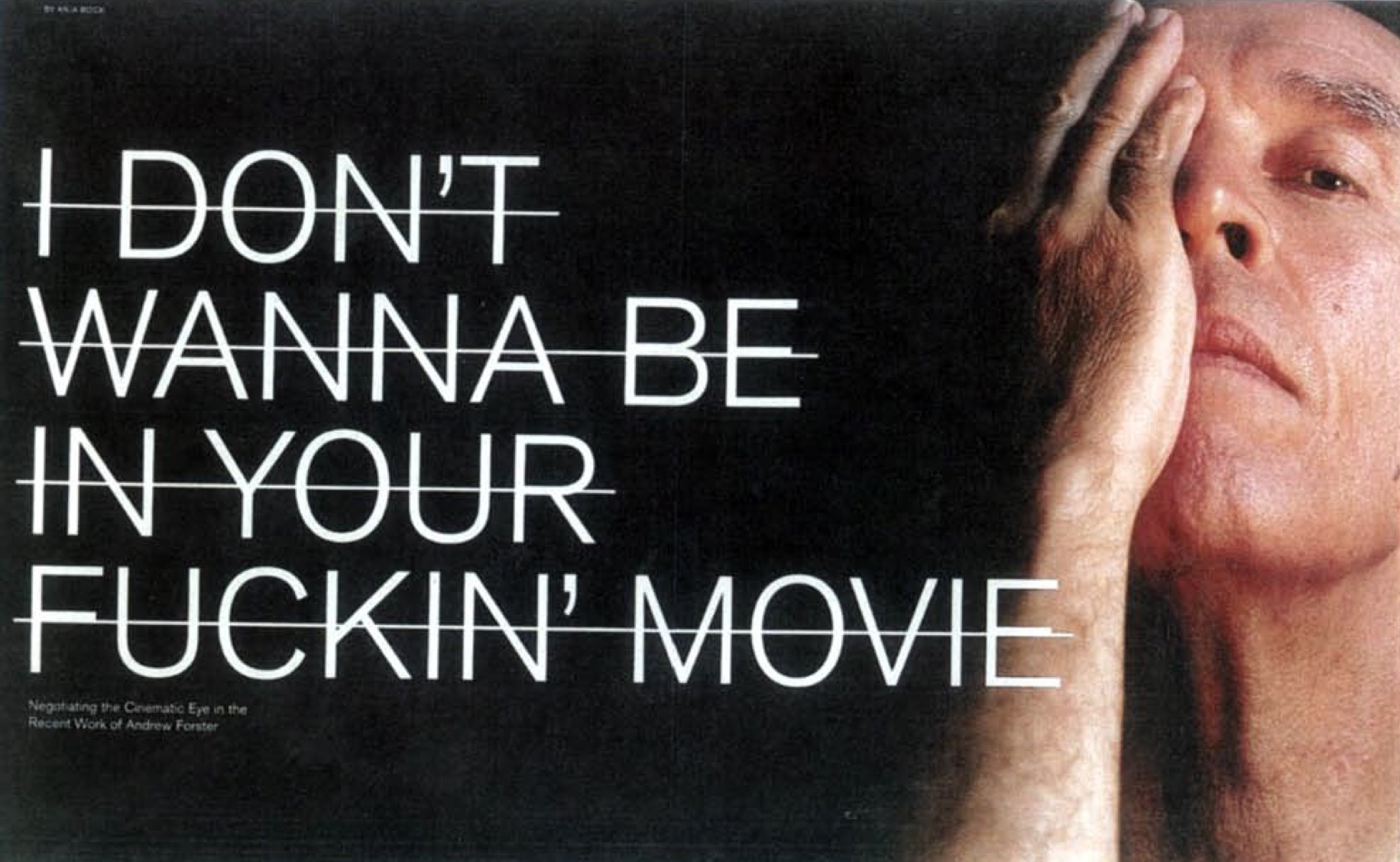
Commentaries
ANJA BOCK "I Don't Wanna be in Your Fuckin' Movie: Negotiating the Cinematic Eye in the Recent Work of Andrew Forster" PREFIX PHOTO, May 2006
On March 24, 2004, television audiences around the world watched as, on the command of Israeli soldiers, a young Palestinian boy cut off the explosives that encased his chest. Hassam Abdo would have died that day along with the soldiers at the West Bank checkpoint he intended to destroy. Reports state that the fourteen-year-old began running toward the soldiers. They aimed their guns and shouted at him to stop; he raised his arms in surrender. A yellow robot was sent to him with scissors. The boy stood alone in front of the cameras, confused and frustrated, struggling to follow shouted instructions, trying to keep his hands up. Once disarmed he was paraded in front of the press in an army coat that was so many times too big for him that it extended to his knees. It was an unforgettable image. Both terrorist and victim, murderer and innocent, Abdo now takes his place in the iconography of war.
One of the central questions for artists who turn their attention to the unfolding of contemporary life is how to prevent political events from becoming reified into icons that pull at the heartstrings, but do little to transmit historical specifics. "Like a miniature guillotine, a camera shutter slices an image from the world," writes Abigail Solomon-Godeau.1 How, then, does one keep the image alive so as to maintain an open and ongoing dialogue? Contemporary artists have at their disposal a material arsenal and a poetic vocabulary that can preserve the vitality of images and prevent their closure for propagandistic purposes.
Hassam Abdo's strange "dance" between life and death forms the basis of two recent works by the Montréal artist Andrew Forster. Cinéma: O fim de Orfeu (2004) is a multidisciplinary performance that was held at the S.A.T. (Société des arts technologiques) in Montréal from October 12 to 15, 2004.2 MOAT (2005) is an evolving video installation that was produced in collaboration with Michael Fernandes and first screened at Space in London from September 15 to October 8, 2005.3 The two works have many common elements: the television footage of Abdo’s surrender and its re-enactment by various performers; the incorporation of live sound and action from their respective sites (the park adjacent to the S.A.T. and in the moat around the Canadian embassy on Trafalgar Square in London); their attesting to the pervasiveness of the "cinematic eye" and its ability to penetrate private and public space; and the confusion of the distinctions between fact and fiction, then and now, here and there.
However, the ways in which these elements are deployed in each work differ greatly, and their formal devices prevent easy assumptions. While it may be said that these works are about terrorism, surveillance and trauma, many other things may be added to this list: exploitation, sensationalism, media manipulation, geopolitics, etc. However relevant these issues may be, Cinéma and MOAT both take definitive measures to prevent any equivalence between them as signs and the referents to which they point. More interesting than what they are about is what they do: by putting audience members in an ambiguous position relative to what they are seeing, these works insist that viewers define for themselves the action they take when watching other people in public space or on the evening news. It is this "work" that Cinéma and MOAT demands of viewers that extends the relevance of these projects beyond illustration and into the realm of political engagement.
CINEMA
The audience shuffles into a makeshift black-box theatre. The seats face toward one of the floor-to-ceiling windows that constitute the walls of this street-level venue. I take my seat three-quarters of the way up, on the aisle, my preferred spot in a movie house. The house lights dim, and with them our reflections in the window. The music begins, and the window is blurred by a curtain of running water. Nothing can be seen on or through this cinema's "screen" but the flow of water and the refracted light coming from the street outside. The bent colours of florescent signs and street lamps merge into each other to make a shimmering tapestry of light. The effect is mesmerizing. The continuous stream solicits a memory of primordial waters, hypnotizing the audience into some sort of netherworld. We hear the footsteps of Orpheus in his manic search through Hades for his beloved Eurydice. "Orpheus!" she yells, cracking her voice. "Eurydice!"4 The show has begun.
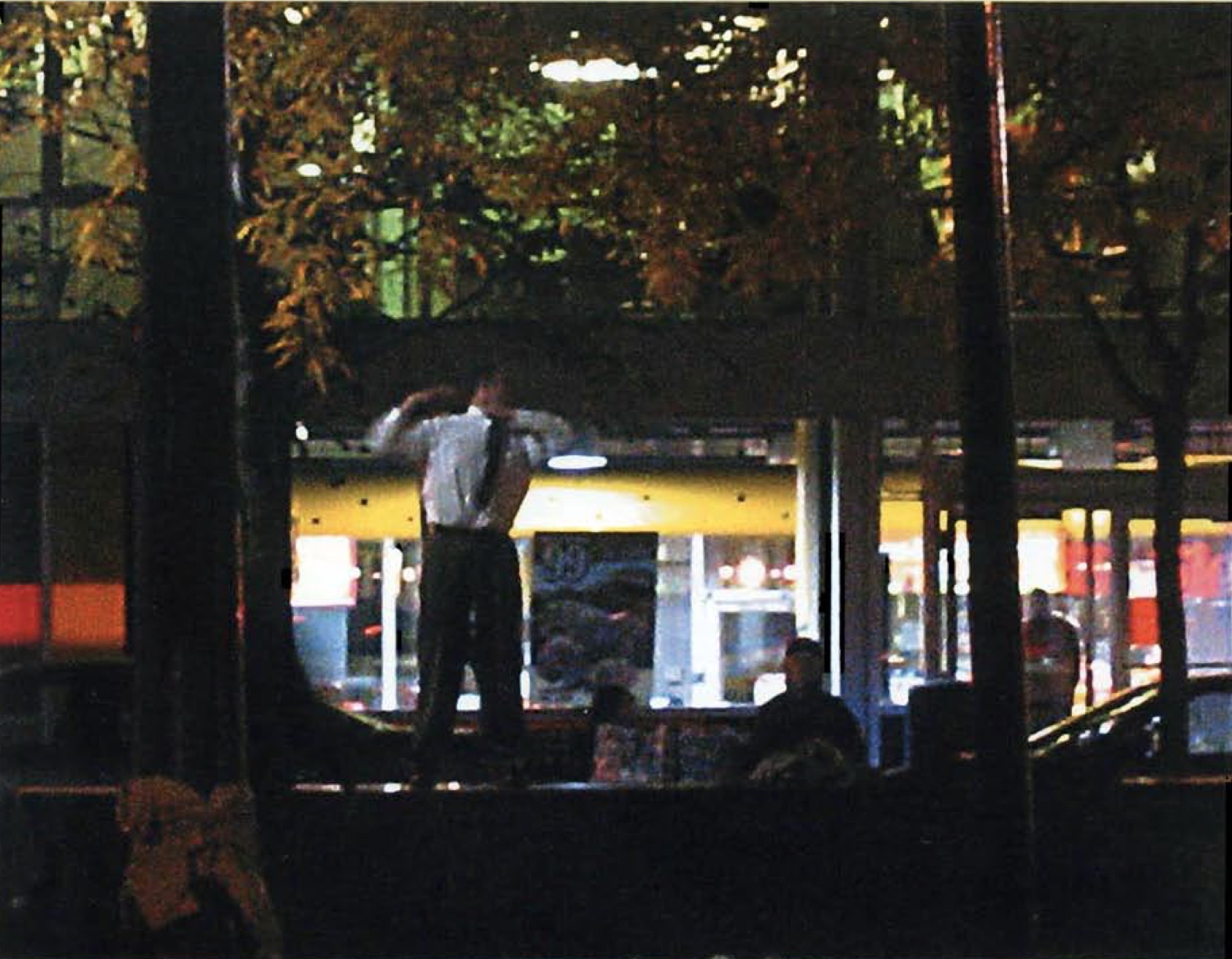
As the water runs dry, the curtain lifts to reveal the Parc de la paix, a grassy city block of the type common to many urban centres, with a few trees and a cluster of benches. Located at the intersection of St. Laurent and René-Lévesque boulevards, this park is used by a mix of office workers, street people, clubbers, drug dealers and sex workers. Two teenagers move a "No Parking" sign ahead by a metre to allow for their car; a man in a pick-up truck pulls up to the curb to negotiate a trick; a couple argues and splits off to different ends of the park before coming back to centre stage to argue some more; drug money changes hands. At the same time, two women walk slowly around the park, deeply immersed in conversation; a man sweeps the park at random; another man shuffles picket signs that state "oui" and "non" as though waiting for a demonstration; another circles the park on his bicycle; and yet another sits and plays the kalimba.
It is uncertain what is scripted and what is happenstance.5 This lack of clarity is further complicated by the fact that the audio track is a mix of both live and pre-recorded elements. We hear the kalimba, but we see that the player has put his instrument down. We hear the traffic roar up St. Laurent, but we see that all the cars are stopped at the light. Again, the curtain of water interrupts the unfolding narrative. It breaks the scene into disjointed fragments that we imaginatively construct into a story in order to ward off the threat that ellipses introduce: Did the argument end with a kiss or a slap in the face? Did the jock get sick of waiting or did his friend arrive? We do not want to admit that our perceptions are as jagged and contingent, so we plot, project, assume and concoct the missing conjunctions. Popular preference is for clearly defined roles, for stereotypes over ambiguity. Here, the stress of not knowing is amplified, as it is almost impossible to sort out what we are looking at and who is who. Are we watching a performance or are we spying on people? It is unclear on which side of the gates to Hades we sit.
In the midst of the dense visual imagery and poetic soundtrack, one performer begins to command our attention. He is a middle-aged man with glasses, dressed in an ordinary business suit and trench coat. We might perceive him to be a regular visitor to the park, except for the fact that his movements are evidently scripted. He is accompanied by a woman who appears to be calling out the orders for his gestures and then helping him with his coat at the end of each sequence. The gestures are those of Hassam Abdo and they echo the orders that we imagine he received at the hands of the Israeli soldiers: hands in the air, take off your coat, reach out and pick up the scissors, cut off the shoulder straps, cut through the vest, hands up! Repeatedly, we see the man perform this series of gestures as though a video were rewinding back to the beginning.
At one point, the performer breaks the rhythm of the sequence and marches up to the glass windows. An image of Abdo is printed on the front of his shirt. He turns quickly and walks away, revealing on his back an iconic image of the Holocaust: a young Jewish boy with bare knees surrendering to the guns pointed at his back during an uprising in the Warsaw Ghetto in 1943. His hands are held high in the air. He is another child victim reified by the camera into an image of a merciless war, but such connections are precarious and Forster's message is far from clear.
Cinéma is not a movie. There is no happy ending that ties it all together. In fact, it never really ends at all, as the visitors to this park continue to inhabit it on an ongoing basis. During the day, they can be observed from any of the hundreds of windows that face onto the park, including those of the S.A.T., which has a café that is convenient for such purposes. The invisible barrier of glass temporarily divides the world between "surveyors" and "surveyed," subjects and objects, between those with the power to look and those who are looked at. The audience has the privilege of sitting inside in the dark watching the actions unfold at a comfortable distance. The activities of sex trade and crack deals are both shocking and run-of-the-mill in our culture. Many audience members were angered by what they saw, seeing perhaps for the first time the destitution that is usually glossed over, the reality that fails to be represented by mainstream media. Others were enthralled by the action and revelled in it, seeing at last an image of reality that is more spectacular, raw and "real" than previous representations: a more credible special effect.
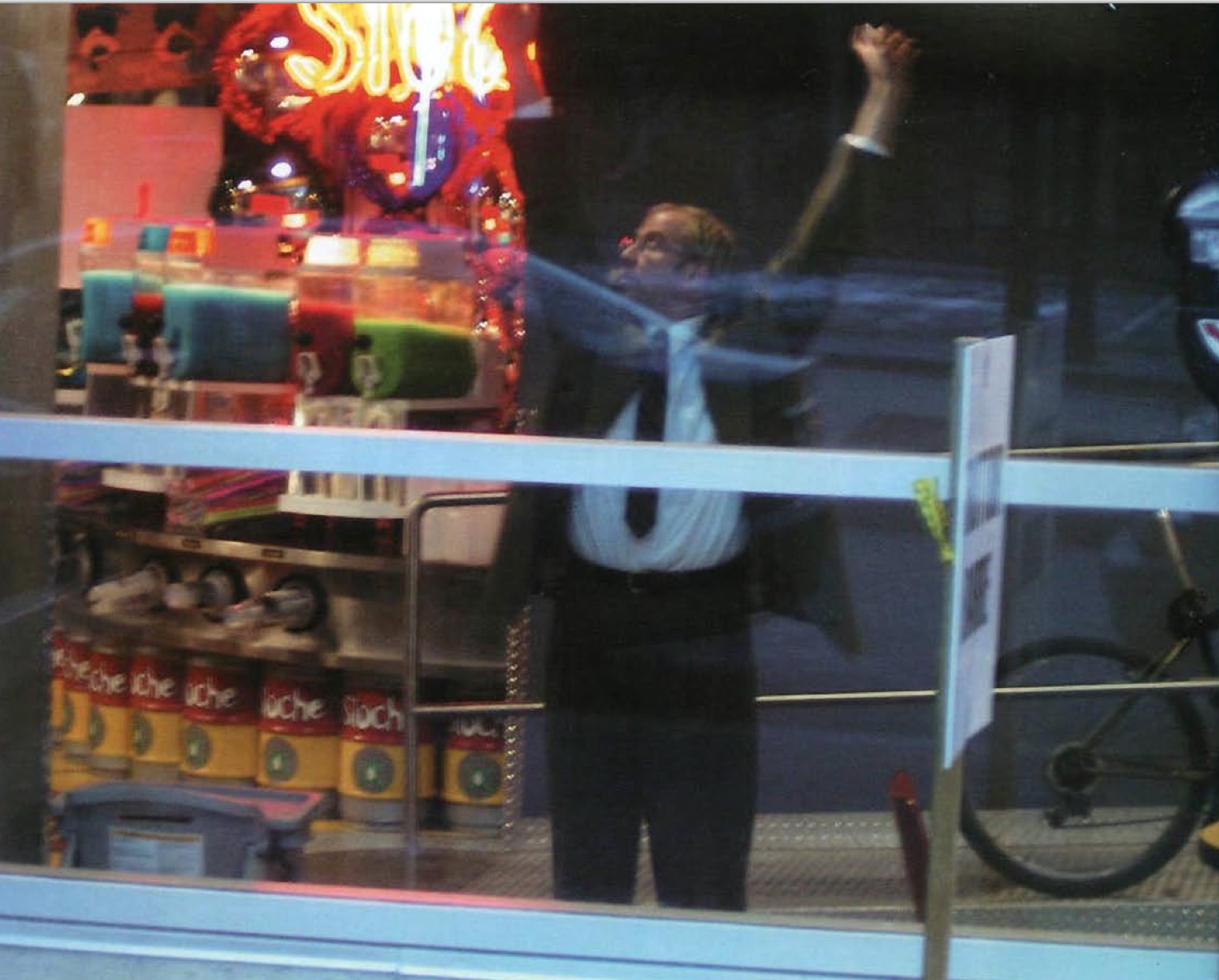
Andrew Forster asks, "What is the use of art in the face of political and social conditions which appear to be beyond our control?"6 Despite their different responses, both groups of audience members responded to what they perceived to be real, the facts among the fiction. This reality surrounds each of us every day, but is usually only observed in detail by the police. For most of us, it is what goes on inside another black box: the television. In this context, the viewer is always on the safe side, watching the other being surveyed, profiled and interrogated. This oppositional dynamic has worn down viewers' ability to respond emotionally. Audiences have become increasingly desensitized by the proliferation of horrific images in both documentary and fictional accounts; some viewers suffer secondary traumatization. The market value of pain and violence and a cultural obsession with trauma continues to gain momentum, so how can we intervene in this process and slow it down enough to be able to interject our own intelligence? Each time we hear "Really, it was just like being in a movie," how can we restore the reality of our experiences without the intermediary of sensationalized images? How can we turn the insatiable cinematic eye into another kind of perspective that is capable of opening things up rather than pinning them down, that allows for empathy and participation rather than objectification?
During one of the four presentations of Cinéma, a First Nations woman who frequents the park yelled at and punched a performer before slapping and pushing two others. Mocking the central actor, she screamed: "Hands up, baby, hands up! Now take off your pants! Hey, Suicide! You take pictures of us! I don't wanna be on camera! I'll smash the fuckin' camera! Cameras out of here! I don't need this fuckin' movie!"7 While there were no cameras in use, Cinéma's crew, whether empathizing or patronizing, was nonetheless trespassing on her territory. The relevance of art is often difficult to assert when other needs are more pressing, when food, shelter and personal safety are lacking. One viewer walked out of the black box and into the park, breaking the cinematic illusion before returning to her seat. This interpretive intervention reinforced the fact that these images are not mere streams of light being projected onto an opaque surface: the people being viewed are real. Her response was to participate in the performance so as to demonstrate the continuity of space shared by park- and Cinéma-goers alike. But the space that Cinéma opens up is not consensual and the possibility of immediate access to the events in the park is an illusion. The screen may be transparent, but that makes it no less operative. 8
Indeed, Cinéma is precisely a mediating machine. By obscuring our vision and scrambling our sense of time and space, by making the ideological barrier of glass visible, Cinéma forces us to acknowledge that what we see is a result of our own projections. The audience is the cinematographer here, adding a particular slant to given events. The narratives of the Parc de la paix can be encoded in various ways, with exploitation and voyeurism marking the extreme poles of abhorrence and enthrallment. Cinéma is in no way didactic or prescriptive: Forster places the burden of interpretive responsibility on the viewer. Yet sitting inside the surveying apparatus limits the range of possibilities. One audience member summarized his experience by saying, "What I hated most about it was that I hated who I was when I was there, because we all just sat there." At the opposite extreme, another viewer said that she resented being put on display in a fish bowl. The experiences of these two viewers differ greatly, demonstrating that the "I" is not necessarily congruent with the "eye" or the "oculus" of the mediating machine.
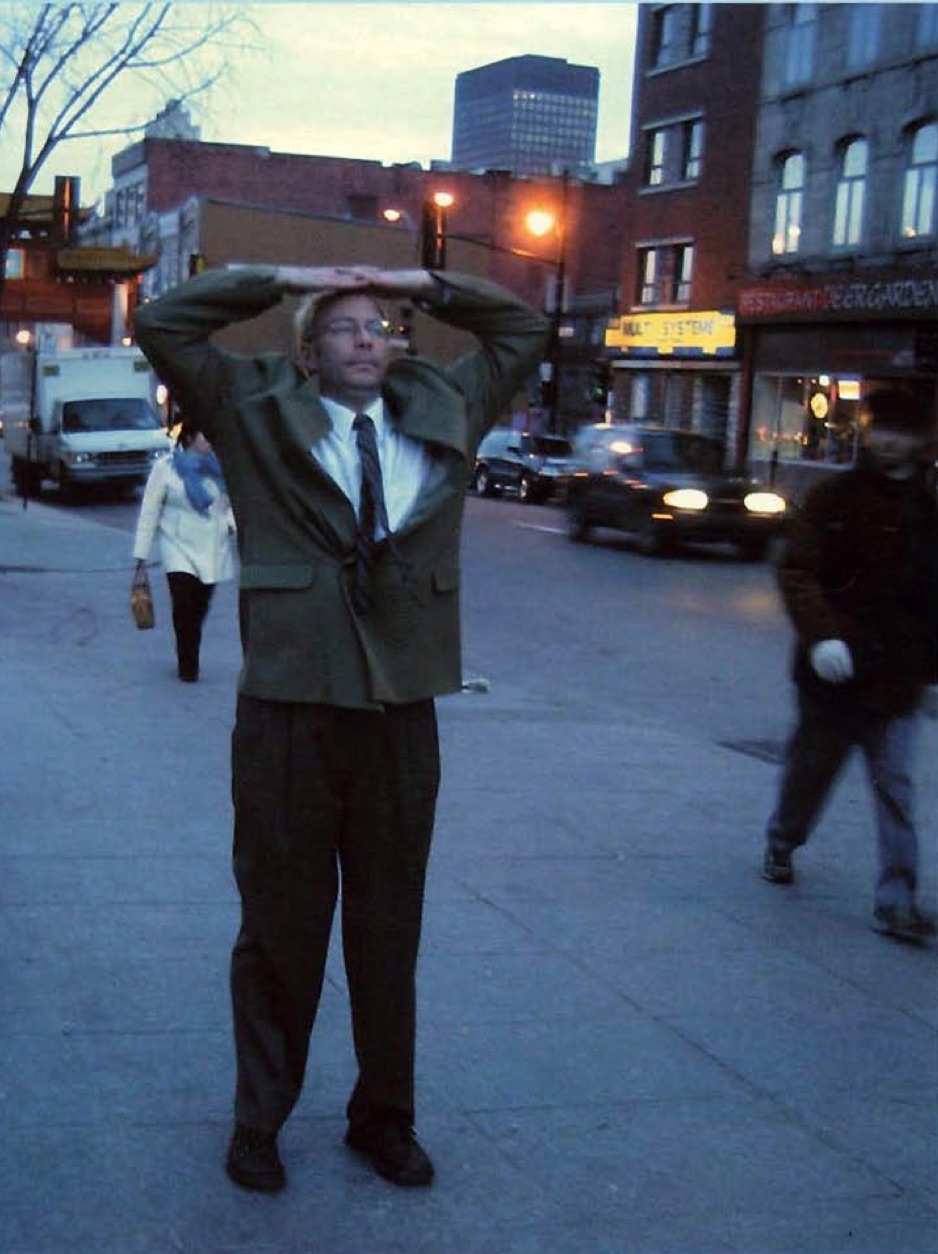
There are, of course, other possible reactions, as well. Perhaps the most condescending and dehumanizing response a viewer could have is pity. The woman's demonstration of anger also demonstrates the danger of infantilizing the disenfranchised, the "poor" poor. Pity increases the distance, whereas empathy brings its object closer. Yet empathy also has its inherent dangers: bringing it too close would be to deny difference and annihilate the other within the self by making it the same. The risk of over-identification must be curbed by maintaining a certain distance. Hassam Abdo's gestures, re-enacted and repeated into absurdity by a seeming businessman in a park half way around the world, allow for an empathic link of identification to be established with the young boy, and the marked differences between them ensure that they are not welded together by borrowed emotions. "There" is now here in our midst, abstracted and turned into art, and yet more nuanced and complex than when presented behind layers of media "takes."
At the end of the performance, the documentary footage of Hassam Abdo plays on a translucent screen near the ceiling. What does our experience of Cinéma add to our understanding of these few minutes of world history? And what does our awareness of the historical source of the repeated gestures add to our understanding of Cinéma? As is often said, the answers we get depend on the questions we ask.
The house lights go up and we stare again at our own reflections in the glass. Now blind to the park, the audience is in the position of the seen object, not the seeing subject. Power can always be reversed.
MOAT
Many of the issues raised by Cinéma are further extended in Forster’s video installation MOAT, which was shot and screened one year later in London. It explicitly editorializes on the previous work and is more pointed in its commentary. What was left open for interpretation in Cinéma is now more definitive: it addresses terrorism and suicide, as well as the political abstractions that obliterate the connections between events in order to erase the trail of cause and effect.
Using C.C.T.V. surveillance technology, MOAT mixes live footage from the site at which it is showing (in this case, the foyer of the Space gallery) with prerecorded materials documenting a diverse range of subjects, including the performance in Trafalgar Square and the moat encircling the Canadian Embassy, the capture of Hassam Abdo, a re-enactment of Abdo's movements, muskoxen in the Canadian arctic, a kite flying in the air. The screen is divided into four sections so that the viewer can see more than one site simultaneously, as would be necessary for a security guard. But occasionally the screen is full and a single quadrant is also divided in four: the sequence is governed by an indiscernible logic. In addition to diegetic sound, MOAT's soundtrack includes voice-overs drawn from news broadcasts, the performers and the angry First Nations woman in the Parc de la paix in Montréal. Dogs bark; the Kalimba plays. Tony Blair repeatedly insists on the need to “protect” ourselves in the face of terrorism. There is no connection between the subway bombings in London and the war in Iraq, he says, as does his Home Secretary. Their spin of "no connection" is rehearsed.
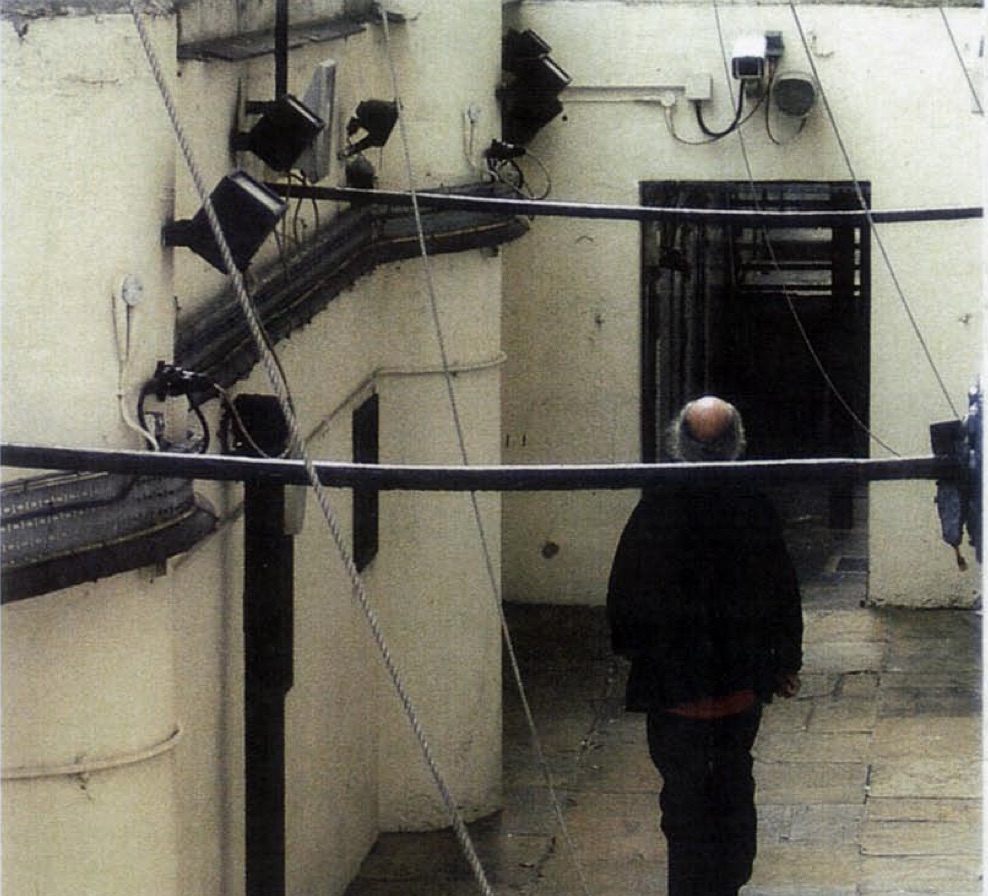
MOAT asks us to imagine such possible connections. Forster has assembled all of these disparate events as if to ask, how? What could be the connection between the angry commentary, the attacks in London and Abdo's suicide mission? "Of course, there is no direct connection between them, is there," says the narrator, "but I imagine that there is one that we can be drawn into, that can be drawn into a consideration of here and there." The voice-over continues:
The situation of the Indigenous people of northern Québec and Labrador, which includes one of the highest suicide rates in the world, is a dark undertow beneath the carefully groomed and presented image of Canada. It is possibly an undertow which reverberates seismically with situations elsewhere, both as contemporary reality and as the outflow of parallel historical actions?
While this text is being narrated, the young boy’s gestures are endlessly re-enacted by different performers, as if trying to connect to each other and the world around them by way of ritualized movement.
As in Cinéma, this exaggerated repetition in MOAT establishes a link that cuts across conceptual and geographical barriers. But what becomes much more clear is the nature of the collaboration between the performers. What Forster describes as "a puppet and puppet-master dialogue between a Palestinian boy with explosives strapped to his chest and his well-armed captors"9 no longer yields to such easy oppostitions. In one corner of the split-screen video, we see two performers, one enacting Abdo's "dance" and the other embodying the Israeli military's voice, as in Cinéma. What is different here is that the two performers engage in a process of improvisational action and reaction. The "soldier" gently takes the arm of the "boy" and places it across his chest, for example, an action to which the boy replies by bringing his other arm down and around to meet it. Although the choreographic framework is that of Abdo's gestures, this collaboration distributes the responsibility; to ask which action was first is futile. What becomes clear in this duet is the fact that identities are always mutually produced in context, mutually dependent and mutually defining. By insisting on the materiality of the two bodies, Forster emphasizes that Abdo’s 'dance' is a site of intersubjective identification and difference. The media often presents identities as though they were essential, as though people have specific attributes for no particular reason; that "they are just like that." But in actuality the formation of identity is a reciprocal process of co-production.
Forster’s use of duet also heightens the sense of intimacy between captor and captive: the shouted voice is replaced by a silent touch. In the original "puppet show," the camera is at the command of the Israeli army and follows the direction of the soldier's orders. In MOAT the distance over which the soldier's voice reached is collapsed and he is in the same space as the boy. As such the eye is drawn into the action, as well, no longer bound to the point of view of an oculus behind security barriers. Viewers can now follow the touch rather than the camera, contradicting the media spectacle and allowing for a drastic redefinition of the event.
There is yet another issue that the repetition of gestures impresses upon the viewer: the incessant repetition of trauma. I do not refer to Hassam Abdo directly but rather to the trauma produced by the subsequent release and circulation of his image, which functions as an event in its own right. Traumatic events, by definition, cannot be integrated into the coping mechanisms that we have at our disposal and, for that reason, exceed comprehension. Abdo's gestures are re-enacted in Montréal and London as if trying to break through into representation. Despite the media's struggle for control over his image, the image itself is not able to communicate effectively due to its many internal contradictions. "Imagine a boy at a checkpoint in Nablus," asks the narrator:
Imagine the choices that suicide offers and the choices that it reveals. Imagine what we call the state of mind. Imagine suicide as a desperate act, as an enlightened act, as a murderous act, as an act of war, as an expression of reality, as a threat to the values we hold dear, as an indiscriminate act. Imagine.
It is the opacity of Abdo's gestures that comes to the fore through their seemingly infinite reenactment in MOAT. Repetition is a way of melancholic processing that will hopefully integrate the traumatic experience and thereby release into mourning. But if turning off our televisions could be seen as a hygienic way to mourn and forget within a split second, MOAT keeps the action in continuous sight, allowing it to cut in before cutting out. As such it is grafted onto external circumstances, allowing it to transform in significance rather than remaining a frozen "slice."
In light of the traumatic events of the early twenty-first century, clinical erasure is highly undesirable, as is extending their purview. What Forster seeks to accomplish in MOAT is both integrating the experience into a larger geopolitical structure and opening a space for independent thought through the poetic language of art. His eye is on the future despite the repetition of the past. At another point in the video, the voice-over poses a seemingly endless list of questions:
Whaddya gonna do when it turns out the other guy is right? When it doesn't matter? When your clothes run out? When it rains all day? Whaddya gonna do now that the wall is down? Now that summer is gone? Now that we are exposed? Now that we know the past?
Although these questions are oppressive in the sense that we could also imagine the question, "Whaddya gonna do when there's no more oxygen?," they function to loosen our assumption of "the way it is." They point to the possibility of change. The image on the screen shows Michael Fernandes in the moat around Canada House, an ambiguous frontier that echoes defense measures that long preceded continuous C.C.T.V. surveillance. He appears to be flying a kite, but there is no kite to be seen. It is gone, just like the bombs, but is held in the memory of the body. But unlike the bombs, which speak of contested borders, war and violence, the kite carries with it the connotation of free open space and far-off aspirations.
Orpheus shuttled back and forth between two worlds for love. Artists play the role of Orpheus in our society, but the romance is gone. Violence on an unforeseen scale marks our contemporary reality. The objective is no longer to transcend, but rather to descend. In answer to Forster's question, the "use" of art in the face of poltical conditions that seem beyond our control is precisely this: to crack through the conventions of representation in order to retrieve what is not being addressed down in the hell of the real, and to raise these things to the surface so that they can be discussed and negotiated. Cinéma allows viewers to observe but not to see clearly, thereby throwing into question the knowledge gained by surveillance and demonstrating the imbalance of power implicit in the apparatus of the cinematic eye. By contrast, MOAT offers the illusion of transparency that surveillance cameras provide, but scrambles the footage so as to question its assumption of coherence and to open the possibility of poetic connections between disparate events. In the first, one sits inside the oculus itself; in the second, the camera is already set. It sees us and we see what it sees – we are both suspect and guard, victim and assailant. To the long list of questions, I would like to add: Whaddya gonna do now that the lines are blurred? that the way is wrong? that the real is bleeding? that the gates are open?
NOTES
1. Abigail Solomon-Godeau, "Remote Control: Abigail Solomon-Godeau's Dispatches from the Image Wars, Artforum 41.10 (Summer 2004): 61, 64.
2. The following individuals collaborated with Andrew Forster on the creation and presentation of Cinéma: O fim de Orfeu: Robert Schweitzer, Monique Romeiko, Marie-Andre Rho, Michael Fernandes, Solomon Diaz, Rainer Wiens, Didier Delfolie-Noulin, Speranza Spiratos (performers); Rainer Wiens (music); Nathalie Claude, Michael Fernandes (voice recording); Francois Girouard, Eric Duval (technicians); and Jack Stanley (technical consultant).
3. In addition to Andrew Forster and Michael Fernandes, the following performers participated in MOAT: Robert Schweitzer, Cecelia Chen, Karsten Kroll and Nicolas Borello.
4. The voices are drawn from the soundtrack of the Brazilian film Orfeu Negro (1958), directed by Marcel Camus.
5. Of the described actions, the walking, sweeping, picketing, cycling and playing were performed by Cinéma collaborators.
6. From the press release for Cinéma.
7. This incident was audio-recorded and subsequently played in the soundtrack for MOAT.
8. Two previous works by Andrew Forster also address the ideological function of a barrier of glass. In Flex (2003), a friendly crowd hits, slaps and pounds the window at the S.A.T. (which had piano microphones amplifying the sound into the interior space). In Ost (2001), the work's title ("east" in German) appears on a window facing east over Montréal’s former industrial centre.
9. From the narration of MOAT.